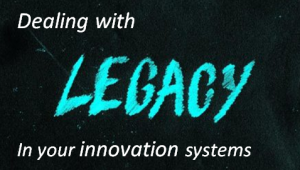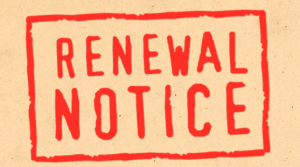 I know the feeling, there has been such a considerable investment that has gone into previous innovation processes to get them established but much of this is actually out of date, it has become today a real ‘legacy’ issue but there is, of course, a real reluctance to challenge it. Well you should!
I know the feeling, there has been such a considerable investment that has gone into previous innovation processes to get them established but much of this is actually out of date, it has become today a real ‘legacy’ issue but there is, of course, a real reluctance to challenge it. Well you should!
Often this reluctance to dispose of these old systems, processes and inadequate frameworks is holding innovation back.
I would argue that perhaps many of our current innovation practices are ‘frozen’ in past times and they significantly slow us down, in a world that is becoming one built increasing on speed, flexibility and adaptability.
We lose precious time as we should be forward looking. constantly learning and experimenting with new concepts and approaches to innovation and what and where these can bring in new growth, sustainability and value to our organisations.
Where does design thinking, lean management, the early thinking to focus more on changing the business model come in? These need to be deliberately designed into your innovation process, not used in a random, ad-hoc approach or as sideshows. They need designing into a new innovation system so they become commonplace and required.
Do innovation labs feature as part of the ongoing innovation development process and how are you building the customer experience? Are you approaching these in well-established structured ways as the defined innovation system or are you constantly refreshing and challenging the system by being adaptive, experimental and fluid in how you manage?
Often we don’t allow ourselves the time, presently seen as a luxury, to call for a comprehensive review of our innovation infrastructure, yet we ought to. Innovation thinking and its approach in design are constantly evolving and we should be keeping pace with these constant developments to realign the latest thinking and the internal processes.
We also should expand out our thinking on innovation beyond the present, lessen the constant looking back and push it a little more towards having a greater emphasis on our future foresight, one that can deliver fresher vision, built on bolder and more rewarding challenges for the pursuit of different growth options .
We need to truly capitalise on the emerging practices of innovation, not just based only on yesterday’s experiments and successes or achieved through outdated past behaviours and thinking.
Firstly you have to start out with why you feel a freshening up should be required, should this be radical, distinctive or incremental. Are you getting so caught up in analysing all the pieces, you are forgetting the bigger picture?
What do you actually want to achieve that takes you closer to your aspirations, not just immediate goals? Can the way you conduct innovation today meet that strategic challenge? Does it ‘advance’ on your current position? Are all business units working on the same system, are they all advancing at a steady speed to a greater maturity? If not, what is holding them back? Do we know, have we asked?
There is a host of reasons ‘renewal’ might be needed. Today, when markets are especially tough, looking long and hard at what you have and jettisoning what you don’t need becomes essential to re-position yourself as leaner and more flexible. There are many pressing needs why you have to ‘shape up’. Don’t ignore the need for renewal, it needs to be a constant in today’s rapidly changing and challenging times. So often when we have finally decided to establish a system of innovation it is already out of date. The use of technology is equally a curse as well as an enabler.
A need for a critical and fresh evaluation of your innovation process
There comes a time where any structure, process, culture or organisation needs a radical rethink and innovation is no different. Please don’t just simply bolt on the next bit, I would argue we need to reflect on this and think differently, re-equip ourselves to meet the present and future challenges and that needs stepping back often and with a fresh clarity of purpose as our markets, customers and innovation approaches are in such constant flux and change.
To achieve this more radical departure from your existing viewpoint, you do need to look at a more structured, methodical approach to your renewal of innovation. Constantly designing, adapting and redesigning into this processes and the required structures so you can keep a more sustaining evolution to your innovation practices. Renewal and legacy reduction become second nature, a constant in your life. Constant upgrades and jettisoning the old approaches as you learn and evolve.
Making the critical steps needs structuring.
Suggesting a structured approach to renewal is not an easy journey; it takes dedicated time and incredible strength of determination but it becoming critical to pursue. The rewards come through an organisation that emerges from today’s ‘uncertainly’ equipped to be more resistant, flexible and agile, so as to seize emerging opportunities quicker, at tomorrow’s new innovation speed, built on latest thinking, design and ‘bleeding edge’ tools and frameworks .
An innovation guide in this is what I call the ‘sense of renewal’ framing, partly based on these suggestions mentioned in that post. It can often help you think through the options, evaluate the existing and compared with the preferred as it gets you closer to the need of your innovation design. So developing a basic problem recognition diagnostic tool that frames this thinking through can help.
A more structured and systematic approach must be taken
I would recommend for building a renewal programme that you can work through a step-by-step approach, enabling clarity and understanding as you go; so everyone involved can see the problems, challenges and then actively contribute to the solutions. This should be our goals always in renewal programmes, inclusion, be these to address societal or business challenges.
What this step-by-step programme does call for, is a very structured, comprehensive investigative approach across the organisation. firstly to build the momentum for recognising what a sense of renewal can bring as important for the future, and then secondly, seeing an emerging clarity for this future built upon a sustaining innovative culture that all contribute and become involved in.
The need for making the case for renewal and charting the path towards the solutions is no different from any other corporate initiative. Making the commitment and getting others to sign on is sometimes hard, but essential. Seeking out places of ‘duplication’ and latent redundancy is also necessary to build into any renewal programmes.

1 thought on “Dealing with the innovation legacy lying within your business.”
Comments are closed.